Photo

The italian Rex (1932) arriving in New York on September 16th 1939. The photo was taken from Cunard’s Aquitania (1914), which at that time (World War II had broken out only weeks before) was already being prepared for her war - time service, as one can see by the covered canon installed on the foreground. Probably unbeknownst to most of the people present on this photo, Italy would enter the war as an Axis power in 1940, putting the Rex and the Aquitania on opposite sides of the conflict. Ironically the Aquitania, by that time already considered an old lady, would survive the war, whilst the much more modern Rex would not (she was sunken by a british airstrike on September 8th 1944 off the coast of Trieste).
Found on pinterest
165 notes
·
View notes
Photo
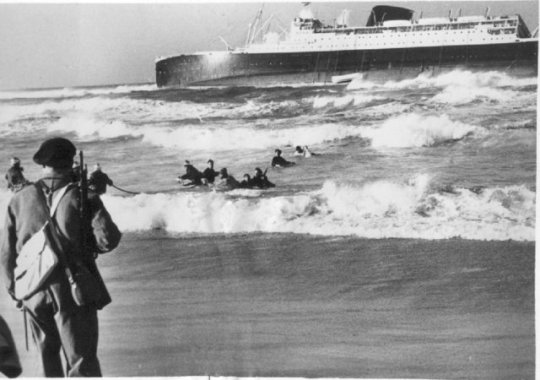
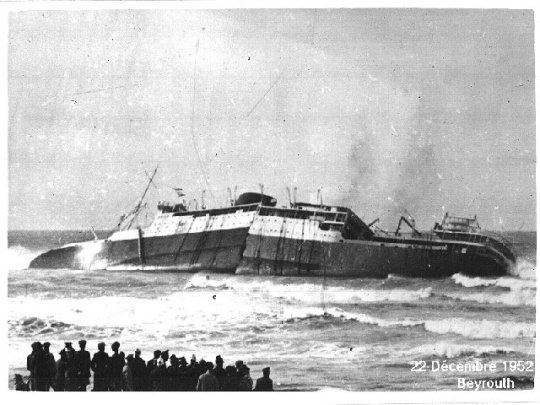
Two picture showing the french Champollion (1924) after she ran aground 600 metres off the lebanese shore in 1952. After three weeks of navegation through stormy weather in the Mediterranean, the Champollion was nearing Beirut, her destination. In the early hours of December 22nd, her crew saw what they believed was the lighthouse signaling the entrance to the port of Beirut. Unbeknownst to them the light they were seeing was, in fact, the signaling light of the airport of a village located a few kilometres south of Beirut. Once the crew noticed their mistake it was already too late: the Champollion ran aground on the shallow lebanese shore. The heavy weather and strong tilt of the wreck meant that the lifeboats couldn’t be lowered. This made the evacuation extremely difficult. The Lebanese Army and the RAF participated in the efforts of saving all passengers and crew. As one can see in the picture above, the passengers had to swim through the water, grabbing a rope which was laid between the Champollion and the shore. 15 died whilst doing this. In the next few days the Champollion broke in many parts and was scrapped soon after.
Source: L’Encyclopadie des Messageries Maritimes
62 notes
·
View notes
Photo
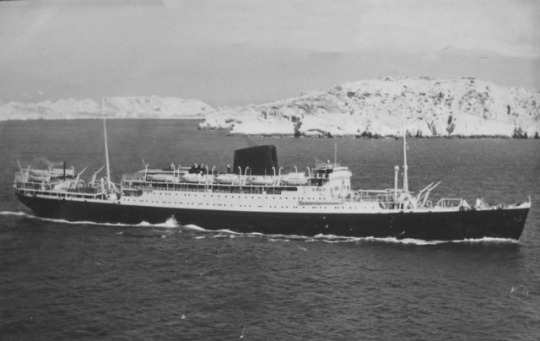
The french Champollion passing the Isles de Frioul, whilst exiting the port of Marseille in 1951. She was built in 1924 for the Messageries Maritimes for the Marseille - Beirut service. Together with her sister ship, the Mariette Pacha, she set new standards on style and confort on the french liners travelling to the east, offering her first class passengers a luxury unknown on earlier ships of the company. In World War II she was requisitioned by the British Royal Navy and served as a troop ship. The Champollion survived the war and was returned to the French in 1945, who continued using her as a troop ship until 1950, when she was returned to the Messageries Maritimes. During that year she was extensively refitted (losing two of her formerly three funnels). Again she operated on the Marseille - Beirut route. However, her post - war career was cut short when she went aground during a storm in 1952, only a few miles south of Beirut. 15 peolple drowned whilst attempting to reach the nearby shore.
Source: L’Encyclopedie des Messageries Maritimes
50 notes
·
View notes
Photo
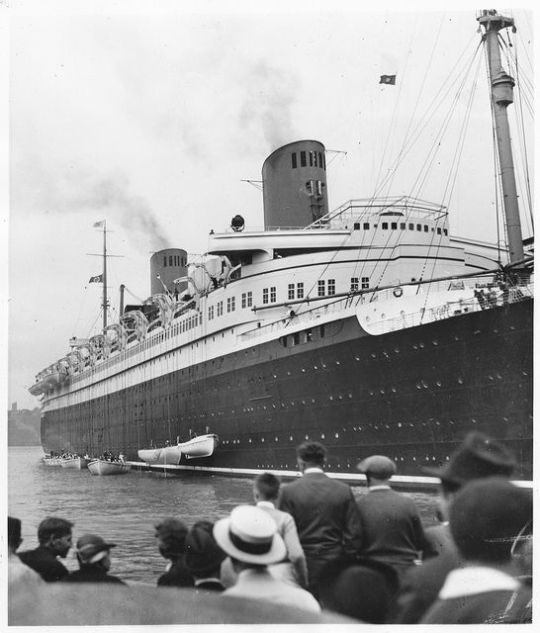
The TS Bremen (1928), testing her lifeboats. Taken sometime in the 1930s.
Found on pinterest
164 notes
·
View notes
Photo
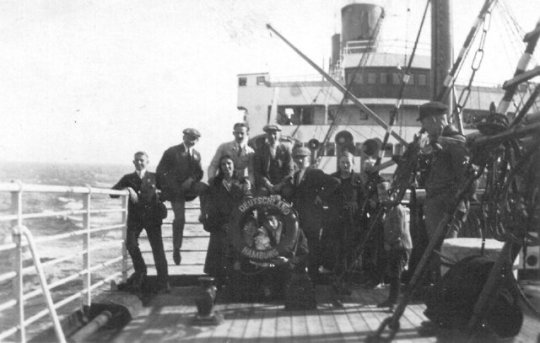
This blurry image shows german immigrants, travelling to New York on board the SS Deutschland (1923) in October 1924.
Source: Die Hamburger Morgenpost
Luxury and opulence are, for the modern observer, the two defining characteristics of the old ocean liners. It might be true that the big shipping companies invested millions in securing that their ships would be stylier and more comfortable than their counterparts from the competition, but, in the end, most passengers never set eyes on these interiors. For millions of travellers the opulence of the first class accomodations was little more than a dream. These were the immigrants and refugees from all parts of Europe, which were hoping to escape the opression in their native countries, their lack of possibilities or their life in poverty. They went to America, to Australia and some even to Africa. For all of them, the ocean liners became a temporary home.
The immigrant trade was one of the principal sources of income for the big shipping companies. New York the most important destiny (although many immigrants travelled further west once they arrived in the US). Both, the company and the city, developed a series of mechanisms to deal with them. New York built a variety of facilities, which controlled everyone who was entering the US. The biggest and most famous one of all surely was located on Ellis Island. Before the ocean liners could dock at their company’s piers, they had to unload all the immigrants in Ellis Island were they underwent a series of tests. The federal government wanted to avoid the entry of people they considered a danger for the society. Sick persons, immigrants which were thought of being mentally unfit or of having a criminal background were sent back to the countries they came from (the authorities tended to use sometimes grotesque techniques to test the newcomers). The lucky ones were given a permanent permission to stay and could board one of the ferries which took them to Manhattan.
The costs of sending the refused immigrants back to where they came from had to be covered by the shipping companies which brought them to New York. This is why most companies, which specialized in the immigrant trade, built gigantic complexes in their European ports in which all immigrants, before boarding the liners, were tested to assure that, once in New York, they wouldn’t be refused. All liners had accomodations for these immigrants which varied in their confort decor. Typical immigrant ships didn’t even had cabins. They had big sleeping halls instead, in which dozen of high beds stood side by side. The passengers were separated depending on if they were men or women travelling alone or families. All these ships had a big lounge, which in most cases also served as dining room. The lounge usually was equiped with a piano, which the passengers could use to organize balls and dances. The day had a strict schedule, necessary to organize life on such a crowded ship. During the journey passengers often made connections, which would come in handy once they would arrive at their destiny. The liner also was the place the passengers left their past behind, wherever they were coming from.
The immigrant trade was dominated by british and german companies, since most immigrants came from countries located beside or near german or british ports (Ireland or Eastern Europe). Companies like HAPAG, the Norddeutscher Lloyd, Cunard or White Star built specialised ships for the immigrant trade, which began to operate in routes that were no where near the companies countries of origin, like from the Mediterranean to New York. Competing for passengers, the confort the ships offered slowly began to improve. In the eve of the outbreak of World War I, ships like the Aquitania (1914) or the Titanic (1912) no longer had big sleeping halls for their third class passengers. The immigrants on these ships slept in real cabins and had much more space availible.
In 1924 the US - Congress sanctioned a new law regulating immigration. For some years now, more and more people had worried that an excess of newcomers could lead to socio - economic problems. The law established a system of quotas, which fixed a number of immigrants that could arrive to the US per year (164.667). The immigrant trade collapsed. Many liners became obsolete and were scrapped, whilst others lost there third class accomodations, which were replaced by the tourist class.
The photo above was taken months after the new Immigration Law came into effect. However, the immigrants to the USA hadn’t changed. In their faces it is still possible to see that mixture of optimism and fear, nostalgia and determination, which marked all immigrants.
21 notes
·
View notes
Photo
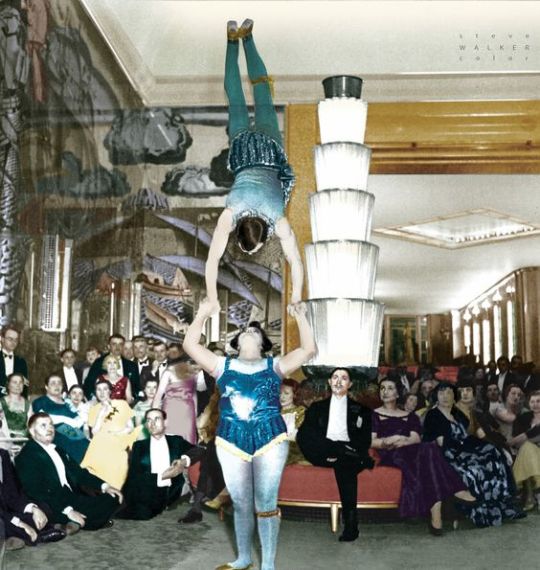
First class passengers on board the Normandie (1935) enjoying a spectacle in the Grand Salon. Coloured by Steve Walker.
Found on pinterest
47 notes
·
View notes
Photo
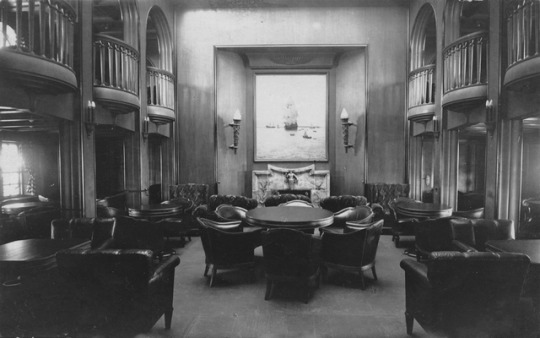
The first class lounge on board HAPAG’s SS Albert Ballin (1922), showing off the cool elegance this ship’s class (which also included the Deutschland, the New York, and the Hamburg) exhibited.
Source: Hiveminer on flickr
Named after the company’s legendary director Albert Ballin, her name had to be changed after the Nazi’s rise to power in 1933, because of Ballin’s jewish descent. She continued operating as Hansa. After the war she was confiscated by the Soviet government. Under the name Sovetskiy Sojuz (in 1980 she was again renamed into Tobolsk) she operated between Wladiwostok and Petropavlosk until 1982, when she was scrapped in Hong Kong.
40 notes
·
View notes
Photo
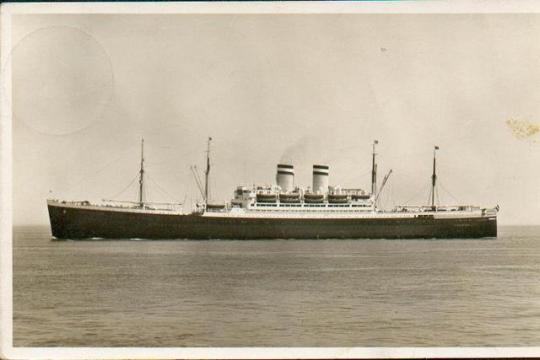
The SS Deutschland (1923) from HAPAG.
Source: Schiffe - Maxim
After losing most of its fleet in World War I, HAPAG was in urgent need of new ships. Following the policy the company’s legendary director Albert Ballin had adopted at the turn of the century, HAPAG wasn’t looking to acquire speedy ships, since their operational costs were to high and powerfull engines could cause annoying vibrations. The company ordered four more or less identical new ships at Blohm & Voss in Hamburg. The second one to be launched was the Deutschland, which in March 27th 1924 set sails for her maiden voyage to New York. She had a relatively low top speed (16 knots). Her interiors were designed rather to be confortable than luxurious and she had large compartments for immigrants travelling to the US. She was also fitted out with anti roll tanks, which made the Deutschland a very stable ship.
Soon the Deutschland became a highy popular both amongst wealthy passengers and immigrants. She operated between Hamburg and New York via Southampton and Le Havre. New engines were installed in 1929, increasing her top speed to 19 knots. As an answer to the huge popularity of the Deutschland, HAPAG decided to extend her length by 14 metres, which increased her passenger capacity.
With the outbreak of World War II she was requisitioned by the German Navy. In 1940 she was reconverted into a swimming accomodation for Navy - personnel. In 1945 she was used to transport german civilians from the besieged Eastern Prussia to the west. She transported more than 70.000 refugees. In the last days of the war the Navy planned to convert her in a Hospital ship. However the paint didn’t suffice for the whole ship to be covered. Before the reconversion ended she was sunken by the same british airstrike which sank the Cap Arkona on May 3rd 1945. The wreck was lifted and scrapped in 1948.
24 notes
·
View notes
Photo

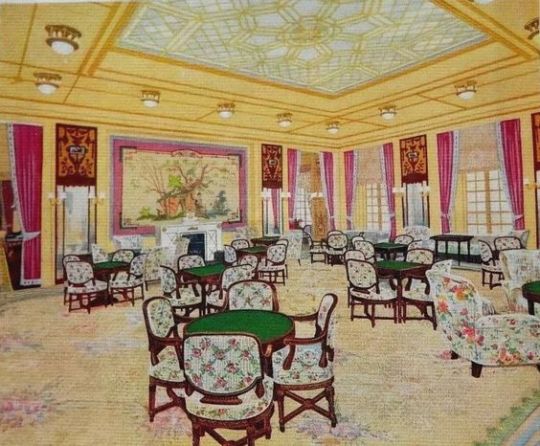

These three colourfull paintings depict various first class interiors of the RMS Homeric. From above to below they show the first class lounge, the Music room and a corridor with writing desks.
Found on pinterest
Originally The Homeric was planned as Kolumbus for the german NDL and construction began in 1913. It was halted during World War 1 and after the war the unfinished ship was confiscated by the British government. In 1920, she was sold to the White Star line, which, after losing the Britannic and Titanic in the years before needed two additional ships to back up the Olympic on its weekly service to New York. One of the replacements was the former Bismarck, renamed Majestic, the other one the Kolumbus, which was renamed Homeric and finally finished. Although slower than her running mates, she quickly gained fame as a steady and reliable liner. However, after the merger of Cunard and White Star after the Great Depression, the Homeric became obsolete and was scrapped in 1935.
53 notes
·
View notes
Photo
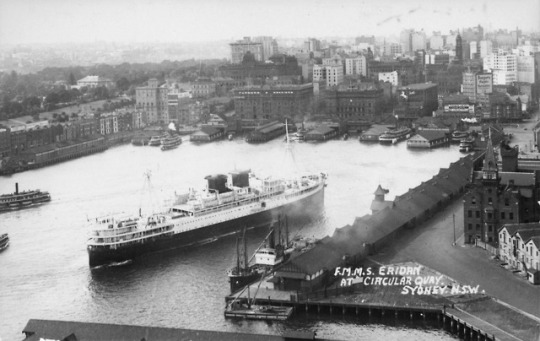
The french Eridan (1928), from the Messageries Maritimes, entering Sydney’s Circular Quay.
Source: L’Encyclopedie des Messageries Maritimes
30 notes
·
View notes
Photo
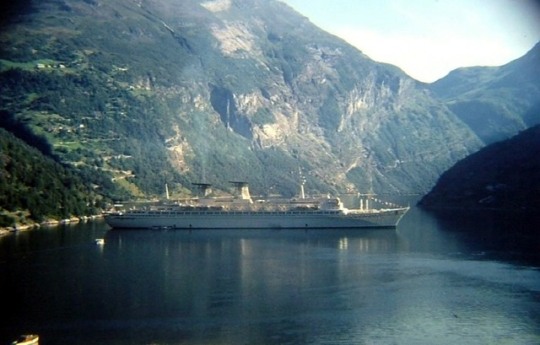
The Michelangelo (1965) in the Geirangerfjord whilst making a cruise to Norway. With the increasing competition by the airplane, cruises like these were becoming more and more necessary as an alternative source of income for the big shipping companies. Photo taken by Saverio Pomposo.
Source: Projecto Michelangelo - Raffaello
44 notes
·
View notes
Text
Also, if one of you guys has got any requests about something you would like me to write about, please let me know and I’ll do my best to fulfill your wishes.
0 notes
Photo

Passengers celebrating the departure of the Raffaello (1965) on to her maiden voyage on July 25th 1965 in Naples.
Source: Project Michelangelo - Raffaello
30 notes
·
View notes
Text
As you might have known, English isn´t my native language. Although I wouldn’t exactly say that I have a bad English level, I’m well aware of the fact that I make mistakes. If you notice them, please let me know. I wont be mad at all. You’d be helping me to mantain a certain quality in my posts for which I’d be very greatfull. Thank you in advance!
10 notes
·
View notes
Photo

A post card depicting the SS Minnesota being coaled in Nagasaki around 1910. Coaling a ship was always an ardous process which involved an intensive work force and a lot of dirt. In fact, whilst loading coal, all the windows and doors had to be closed to avoid the coal dust to enter. After the process was finished, all the decks had to be cleansed extensively. Coaling a ship was more dfficult in ports of less developed countries (as Japan was before WW2), since they usually had a very insufficient infrastructure. It was only when after WW1 most ships started being fired by oil, that refueling was considerably eased.
Source: gcaptain
41 notes
·
View notes
Photo

The Leviathan (built es Vaterland in 1914 for the HAPAG), leaving Boston docks for her sea trials. The photo is part of a series made by Leslie Jones, documenting the Leviathans reconversion into an US line - ocean liner in New York and Boston in 1923.
Source: The Boston Public Library on flickr
233 notes
·
View notes
Photo

First class passengers enjoying a game of Shuffleboard on the boat deck of the Leviathan (built in 1914 as Vaterland for the HAPAG), sometime in the 1920s.
Found on pinterest
51 notes
·
View notes